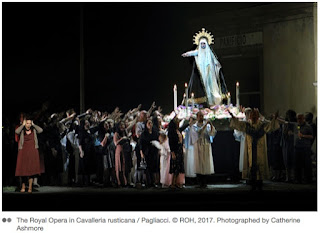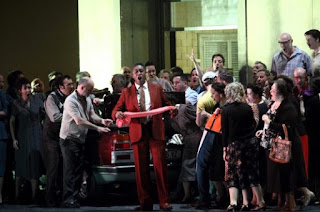(Review in English below)
As óperas Cavalleria Rusticana (Pietro Mascagni) e Pagliacci (Ruggero Leoncavallo) são inquestionáveis expoentes do verismo que marcaram o cenário lírico italiano no final do século XIX. A sua apresentação em conjunto fê-las ganhar dimensão e projeção no mundo lírico, não porque não tenham qualidade para serem apresentadas individualmente, mas pela sua reduzida dimensão e pelo contexto que as liga: ambas são histórias de amor, ciúme, ódio, crime e tragédia. Ambas tragédias populares que são a vida de todos.
Assisti à produção da Royal Opera House do passado dia 2 de Dezembro de 2017.
Trata-se de uma produção dirigida por Damiano Michieletto que a ROH estreou em 2015. E é muito interessante. Tudo se passa num cenário rural sobre um palco giratório.
Começando pela Cavalleria Rusticana, a taberna passa a ser uma padaria com um enorme letreiro a dizer “Panificio”. Mas a cena do vinho é passada no exterior da padaria, onde estão umas mesas e bancos corridos, pelo que em nada transtorna a acção. Começa com a população estática reunida em torno de Turiddu já morto, enquanto a sua mãe chega e o chora desesperada. Depois toda a acção decorre em analepse. E a sequência da acção desencadeia-se com dinamismo. Tem três pormenores que destacaria. A colocação de cartazes a anunciar “Pagliacci”, a igreja transformada numa procissão em que a Nossa Senhora aponta o dedo à excomungada Santuzza e, durante o Intermezzo, a oferta de um lenço e a troca de um beijo entre um padeiro e uma jovem que são o Sílvio e a Nedda de Pagliacci.
O palco rotativo mantém-se em Pagliacci. Usam-no para mostrar um camarim, a entrada de uma sala polivalente de um colectivo popular cujo interior é dotado de um palco. Tonio surge no camarim e apresenta-se como Prólogo. Depois a acção decorre de forma fluida de cena para cena. Interessantemente, no Intermezzo surge Santuzza a confessar-se a um padre, sendo, de seguida, recebida pela Mamma Lucia que a abraça e lhe acaricia o ventre que espera um filho de Turridu, numa forma interessante de, por um lado, a absolver, e de, por outro, dar continuidade a uma história terminada abruptamente. Termina com Tonio a dizer que a comédia acabou, enquanto se acendem projectores que iluminam o público, envolvendo-o na tragédia.
Tudo decorre representando um povo rude e agressivo, mas é isso que se espera de uma localidade rústica do sul de Itália ainda que transportada para os anos 60. Diria, pois, que são encenações interessantes e que proporcionam uma ligação entre ambas as óperas que enriquece a experiência do público e que em nada adultera os significados das histórias.
© Catherine Ashmore
A Cavalleria Rusticana apresentava, como um dos atrativos principais, a estreia de Elina Garanca como Santuzza. Esteve, de facto, em grande nível com uma voz extremamente adequada ao papel e que promete poder crescer mais. Foi óptima nas suas diversas cenas “Inneggiamo”, “Voi lo sapete, o Madre”, ou “Tu qui, Santuzza?”. Cenicamente representou uma Santuzza desiludida com o seu amor, sem futuro, rejeitada por todos e dilacerada por ter denunciado Turiddu a Alfio.
© Catherine Ashmore
Alfio foi o barítono Mark Doss que é dotado de uma voz com um enorme volume e um timbre muito interessante, tendo conseguido catapultar-se para uma excelente prestação. A mamma Lucia de Elena Zilio esteve igualmente bem, transmitindo ao público o desespero da mãe que perde o seu filho. A Lola de Martina Belli foi sedutora e provocante, ao que aliou uma boa prestação vocal.
© Catherine Ashmore
O maior destaque foi para o Turiddu de Bryan Hymel. É um tenor que muito aprecio pelas suas qualidades técnicas, beleza tímbrica e qualidade cénica. Diria que foi um Turiddu quase perfeito e a sua interpretação de “Mamma, quel vino è generoso” foi sublime não apenas pelos agudos fáceis, mas sobretudo pela emoção que o trio da voz e expressões emocional e corporal passaram para o público.
No Pagliacci, Bryan Hymel volta a ser o protagonista no papel de Canio. E voltou a brilhar, oferecendo um “Vesti la guibba” impressionante.
O Tonio de Simon Keenlyside também foi perfeito: a voz é belíssima e dotada de uma expressão e lirismo assinaláveis. Também as suas qualidades como ator tornaram o seu Tonio muito convicente.
© Catherine Ashmore
Carmen Gianattasio foi também uma Nedda interessante: tem uma voz muito bonita e uma boa presença em palco, apontando-lhe a dicção como um defeito. O Beppe de Luís Gomes foi de muito boa qualidade, assim como o Sílvio de Andrzej Filonczyk que tem uma bonita voz de barítono e se mostrou um amante apaixonado.
O coro apresentou uma enorme qualidade em ambas as óperas, assim como a orquestra da ROH que foi dirigida por um Daniel Oren inspirado.
Dada a qualidade global e homogeneidade vocal pode afirmar-se que se assistiu a um grande espectáculo.
————-
(Review in English)
The operas Cavalleria Rusticana (Pietro Mascagni) and Pagliacci (Ruggero Leoncavallo) are unquestionably exponents of verismo that marked the lyrical Italian scene in the late nineteenth century. Their presentation together made them gain a new dimension and projection in the lyrical world, not because they do not have quality to be presented individually, but because of their small size and the context that connects them: both are stories of love, jealousy, hatred, crime and tragedy. Both popular tragedies that are everyone's life.
I attended the production of the Royal Opera House on 2 December 2017.
It is a production directed by Damiano Michieletto that the ROH debuted in 2015. And it's very interesting. Everything happens in a rural setting on a rotating stage.
Starting at Cavalleria Rusticana, the tavern becomes a bakery with a huge sign saying "Panificio". But the wine scene is passed outside the bakery, where there are tables and benches running aside, so that nothing upsets the “normal” action. It begins with the static population gathered around Turiddu already dead, while his mother arrives and cries him desperately. Then all the action takes place in analepse. And the sequence of action unfolds with dynamism. It has three details that I would highlight. Placing signs announcing "Pagliacci", the church transformed into a procession in which Our Lady points the finger at the excommunicated Santuzza, and during the Intermezzo, offering a handkerchief and exchanging a kiss between a baker and a young woman who are Silvio and Nedda of Pagliacci.
The rotating stage remains in Pagliacci. They use it to show a dressing room, the entrance of a polyvalent hall of a popular collective whose interior is endowed with a stage. Tonio appears in the dressing room and is presented as Prologue. Then the action flows smoothly from scene to scene. Interestingly, in the Intermezzo Santuzza arises to confess to a priest, being then received by Mamma Lucia who embraces and caresses the belly that awaits a son of Turridu, in an interesting way of, on the one hand, to absolve, and, on the other hand, to give continuity to a story abruptly ended. It ends with Tonio saying that the comedy is over, while lighting projectors that illuminate the public, enveloping it in the tragedy.
It all happens to represent a rude and aggressive people, but this is what is expected of a rustic locality of the south of Italy although transported to the 60s. I would say, therefore, that they are interesting scenarios and that they provide a connection between both operas that enriches the experience of the public and that in no way adulterates the meanings of the stories.
Cavalleria Rusticana presented, as one of the main attractions, the debut of Elina Garanca as Santuzza. She was, in fact, on a high level with a voice that was extremely fit for the role and that promises to grow more. She was great in her various scenes "Inneggiamo", "Voi lo sapete, o Madre", or "Tu qui, Santuzza?". Cenically she represented a Santuzza disillusioned with her love, without a future, rejected by all and torn for having denounced Turiddu to Alfio.
Alfio was the baritone Mark Doss who is endowed with a voice with a huge volume and a very interesting timbre, having managed to catapult himself for an excellent performance. Elena Zilio's Lucia was equally well, conveying to the public the desperation of the mother who loses her son. The Lola performed by Martina Belli was seductive and provocative, to which allied a good vocal performance.
The biggest highlight was for Bryan Hymel's Turiddu. He is a tenor that I greatly appreciate for its technical qualities, voice beauty and scenic quality. I would say that he was a near perfect Turiddu and his interpretation of "Mamma, quel vino è generoso" was sublime not only by the easy highs, but especially by the thrill of the trio of voice and emotional and corporal expressions passed to the public.
In Pagliacci, Bryan Hymel returns to be the protagonist in the role of Canio. And he returned to shine, offering an impressive "Vesti la guibba".
Tonio by Simon Keenlyside was also perfect: the voice is beautiful and endowed with a remarkable expression and lyricism. Also his qualities as an actor have made his Tonio very convincing.
Carmen Gianattasio was also an interesting Nedda: she has a very beautiful voice and a good presence on stage, pointing to her diction as a defect. The Beppe by Luís Gomes was of very good quality, as was Sílvio by Andrzej Filonczyk, who has a beautiful baritone voice and was a passionate lover.
The choir presented a tremendous quality in both operas, as well as the ROH orchestra which was directed by an inspired Daniel Oren.
Given the overall quality and vocal homogeneity it can be affirmed that a great show was seen.










Obrigado pelo relato interessante, só uma pequena nota - a estreia da Elina Garanca como Santuzza já tinha acontecido em finais de 2016 em Paris, na Bastilha, estive lá e gostei muito dela. Infelizmente a "segunda parte" nāo foi um Paglacci, mas um Sancta Susanna da pesada! Jorge Soares
ResponderEliminar